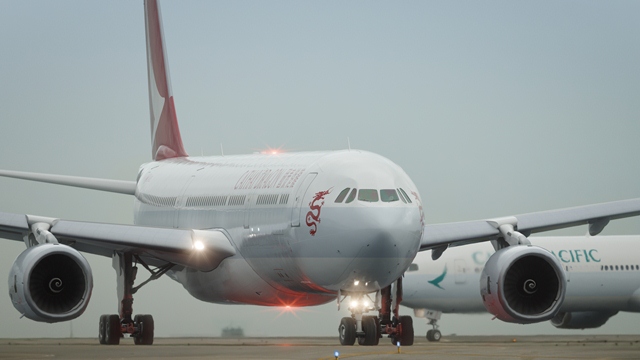 The Cathay Pacific group carried 90% fewer passengers in March and 52% fewer passengers in the first quarter of the year than it did in the same periods last year and expects no improvement in its performance for April.
The Cathay Pacific group carried 90% fewer passengers in March and 52% fewer passengers in the first quarter of the year than it did in the same periods last year and expects no improvement in its performance for April.
Cathay Pacific and Cathay Dragon carried a total of 311,128 passengers last month, a decrease of 90% compared to March 2019 as the global COVID-19 pandemic continued to intensify with more and tightened travel restrictions and quarantine requirements implemented in Hong Kong and other markets.
The month’s revenue passenger kilometers also fell 84.3% year-on-year. Passenger load factor slid by 34.6 percentage points to 49.3%, while capacity decreased by 73.2%.
The two airlines carried 119,277 tonnes of cargo and mail last month, a decrease of 35.6% compared to March 2019. The month’s revenue freight tonne kilometers also fell 29% year-on-year. The cargo and mail load factor increased by 9 percentage points to 77.4%, while capacity was down by 37.2%.
“Overall, we carried 90% fewer passengers in March and 52% fewer passengers in the first quarter than we did in the same periods last year” while load factor for the month dropped to 49.3% only, Cathay Pacific group chief customer and commercial officer Ronald Lam said in a statement.
Significant declines were seen across all traffic types. “Passenger demand dropped rapidly and tremendously in late March following the introduction of arrival restrictions on all non-resident visitors to Hong Kong, including transit passengers. On each of the last two days of March we carried fewer than 1,000 passengers only,” said Lam.
On its cargo business, “while we continue to operate a full freighter schedule, our passenger flight reductions have had a significant impact on our overall cargo capacity,” Lam continued. “Our cargo volumes were down, but load factors and yield were up due to air cargo capacity reduction in the global market.”
He added: “To support global supply chains at this critical time, we have been adding cargo capacity in the form of more freighter flights as well as a total of 257 pairs of cargo-only passenger flights in March.
“We currently expect to operate a similar number of cargo-only passenger flights in April, including on some long-haul routes such as the Southwest Pacific where air cargo capacity is extremely tight.”
The resumption of production in mainland China saw exports from Hong Kong and the mainland rebound following a weaker February. However, other transshipments were negatively impacted by lockdowns and emergency measures in various markets in the second half of the month, in particular the India sub-continent.
The commodity mix also changed with a surge in the transportation of medical supplies such as face masks, protective clothing, hand sanitizer and other pharmaceutical products. On the other hand, the volume of consumer goods such as garments and automobile parts declined.
Looking ahead, Lam said a recovery timeline in customer demand remains impossible to predict.
“We still do not see an improvement in our advance passenger bookings and we are anticipating average daily passenger numbers to remain below 1,000 throughout April. On a typical day we would normally expect to carry some 100,000 passengers; earlier this week, this had dropped to 302 only on one day.”
The company will be operating a bare skeleton passenger flight schedule comprising 3% of its normal capacity in April and May.
Photo courtesy of Cathay Pacific





